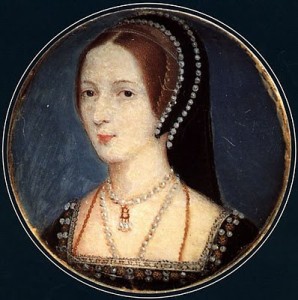 On this day in history, Tuesday 26th August 1533, Anne Boleyn, second wife and queen consort of King Henry VIII, prepared for the birth of her child by “taking her chamber”, i.e. entering a female only environment, for the final weeks of her pregnancy.
On this day in history, Tuesday 26th August 1533, Anne Boleyn, second wife and queen consort of King Henry VIII, prepared for the birth of her child by “taking her chamber”, i.e. entering a female only environment, for the final weeks of her pregnancy.
It was usual for a woman in those times to take to her chamber four to six weeks before the due date of her baby but 26th August was actually less than two weeks before Anne’s baby, the future Queen Elizabeth I, was born. Chronicler Edward Hall records that in the summer of 1533 “the kyng kept his progresse about London, because of the Quene” and we know from contemporary records that carpenters carried out work on Greenwich Palace to prepare the Queen’s chambers for her confinement. Eric Ives notes in his book on Anne that “details of the arrangements were handed on from one royal confinement to the next” with William Mountjoy, Catherine of Aragon’s lord chamberlain, writing to Thomas Cromwell on 24th July:
“I send you certain remembrances of things to be provided against the Queen’s taking her chamber, of which I had experience when I occupied the room.”
On 19th August 1533, George Taylor, Anne Boleyn’s receiver general, wrote to Lady Lisle in Calais of the arrangements for the queen’s confinement:
“The King and Queen are in good health and merry. On Thursday next they will come by water from Windsor to Westminster, and on Tuesday following to Greenwich, where the Queen intends to take her chamber.”
On 26th August 1533, the queen attended a special mass at Greenwich Palace’s Chapel Royal and then processed with her ladies to the Queen’s great chamber. Before retiring to the special chamber, Anne and her ladies enjoyed a refreshment of wine and spices and then Anne’s lord chamberlain prayed that God would give the Queen a safe delivery. The queen and her ladies then entered her chamber to await the birth of Anne’s child.
Further Resources
You can read more about what the chamber would have been like in my article from 2013 – click here. Members of our sister site, the Tudor Society, can enjoy my video talks on Margaret Beaufort’s Ordinances (ordinances written by Margaret Beaufort, Henry VII’s mother, in 1486 for the pregnant Elizabeth of York, which were followed for subsequent royal births) and Building work at Greenwich Palace 1532-1533 (about the work carried out on the palace after Anne had become queen and in preparation for the birth of her child).
Notes and Sources
- Hall, Edward (1809) Hall’s chronicle: containing the history of England, during the reign of Henry the Fourth, and the succeeding monarchs, to the end of the reign of Henry the Eighth, in which are particularly described the manners and customs of those periods. Carefully collated with the editions of 1548 and 1550, J. Johnson, p. 805.
- Ives, Eric (2004) The Life and Death of Anne Boleyn, Wiley-Blackwell, p.184.
- Letters and Papers, Foreign and Domestic, Henry VIII, Volume VI, 890.
- Ibid., 1004.